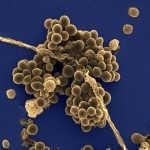Lien vers Pubmed [PMID] – 24797265
Mol. Cell Proteomics 2014 Sep;13(9):2168-82
Serine-rich (Srr) proteins exposed at the surface of Gram-positive bacteria are a family of adhesins that contribute to the virulence of pathogenic staphylococci and streptococci. Lectin-binding experiments have previously shown that Srr proteins are heavily glycosylated. We report here the first mass-spectrometry analysis of the glycosylation of Streptococcus agalactiae Srr1. After Srr1 enrichment and trypsin digestion, potential glycopeptides were identified in collision induced dissociation spectra using X! Tandem. The approach was then refined using higher energy collisional dissociation fragmentation which led to the simultaneous loss of sugar residues, production of diagnostic oxonium ions and backbone fragmentation for glycopeptides. This feature was exploited in a new open source software tool (SpectrumFinder) developed for this work. By combining these approaches, 27 glycopeptides corresponding to six different segments of the N-terminal region of Srr1 [93-639] were identified. Our data unambiguously indicate that the same protein residue can be modified with different glycan combinations including N-acetylhexosamine, hexose, and a novel modification that was identified as O-acetylated-N-acetylhexosamine. Lectin binding and monosaccharide composition analysis strongly suggested that HexNAc and Hex correspond to N-acetylglucosamine and glucose, respectively. The same protein segment can be modified with a variety of glycans generating a wide structural diversity of Srr1. Electron transfer dissociation was used to assign glycosylation sites leading to the unambiguous identification of six serines and one threonine residues. Analysis of purified Srr1 produced in mutant strains lacking accessory glycosyltransferase encoding genes demonstrates that O-GlcNAcylation is an initial step in Srr1 glycosylation that is likely required for subsequent decoration with Hex. In summary, our data obtained by a combination of fragmentation mass spectrometry techniques associated to a new software tool, demonstrate glycosylation heterogeneity of Srr1, characterize a new protein modification, and identify six glycosylation sites located in the N-terminal region of the protein.



